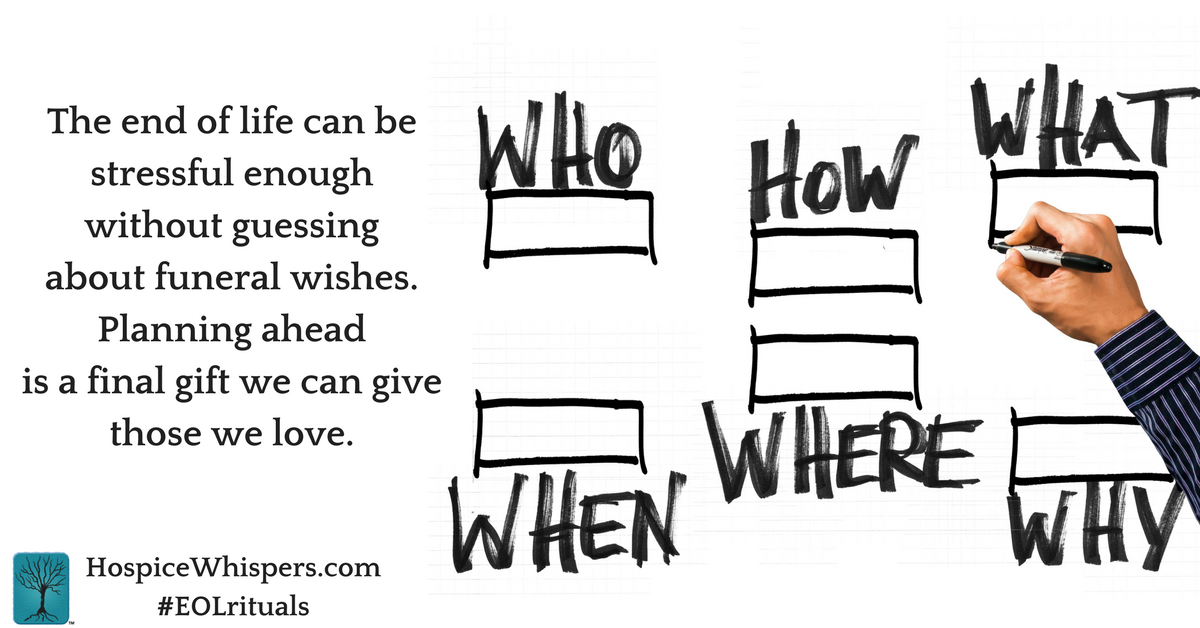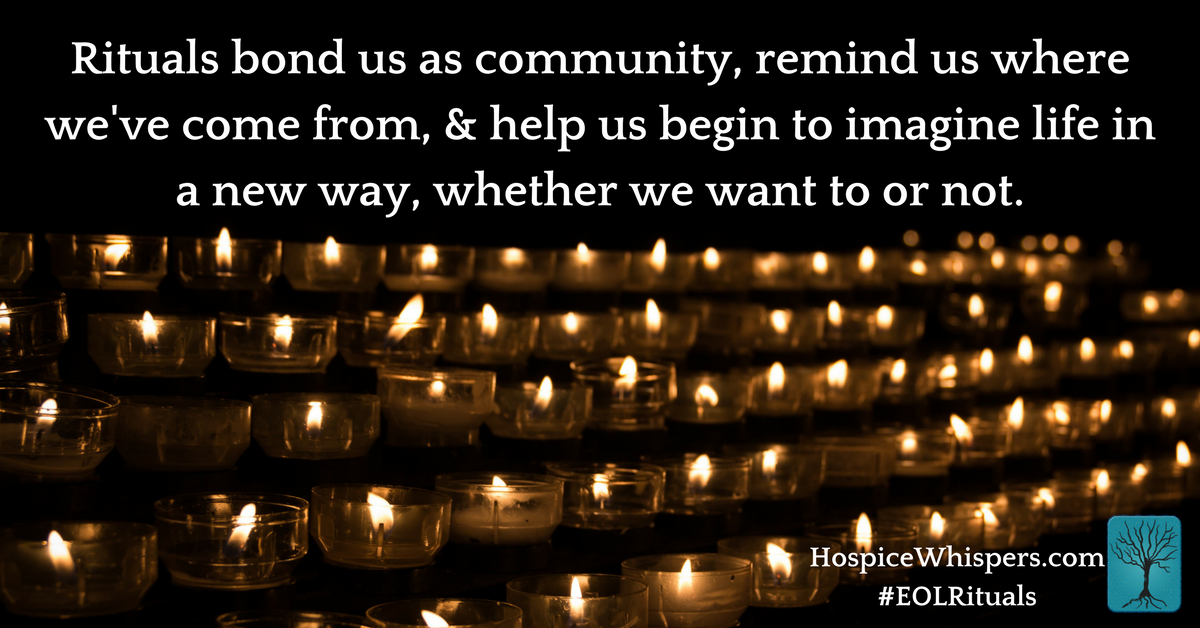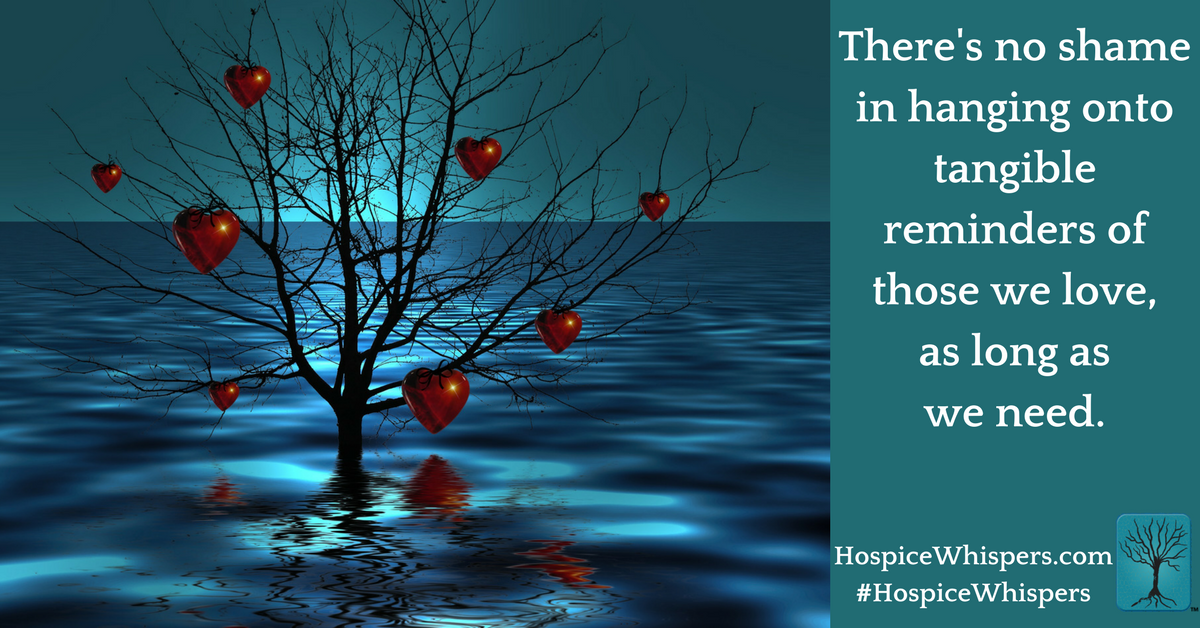What We Need to Know About End of Life Rituals Part II: Planning Ahead?
End of life rituals are important, but they are also a mystery to many. In this series, I’ll share the art and science of funerals, memorials, etc. to help lay persons planning for their own, or their loved ones, and professionals seeking to guide them.
There are two things I do not suffer from: brevity and long-range organization. I’m one of those who naturally enjoy working with the adrenaline of a deadline. For years, I scoffed at planning ahead, so it’s a grown-up skill I’ve gotten to learn along the way in my career. Honestly, I still have much to learn!
The importance of having one’s wishes known well ahead of a medical crisis cannot be overstated. Watching families caught off guard, uncertain what mom or dad, a sibling or spouse, would want for their end of life care is sad and frustrating. These wishes and decisions include what one wants to happen with their body after death.
Sometimes, it’s clear, as persons are very open with verbalizing their wishes. Thankfully, many take the important step of actually writing them down and/or pre-arranging with a funeral home or other agency. When folks’ desires are well-known, the relief their loved ones feel is abundantly clear. When arrangements have already been made, it’s that much better.
When a person dies, no matter how well-prepared we think we are, the emotional, mental, and physical stress catches just about everyone off guard. Trying to make decisions when our brains and hearts are trying to wrap themselves around the sudden absence of one we love and our pre-frontal cortex is shut down in distress is way too hard.
Far too often I see persons denied the necessary space to grieve because they are too busy navigating logistics. Again, when we’re hurting, we’re not thinking clearly. Making decisions on behalf of someone else, trying to please everyone and hack off no one, and plan a ritual that will help you, too, can be too much!
There is no reason to not make these plans ahead of time. So what exactly needs to be considered? I’ll write in more detail about each of these topics in the coming weeks, but here’s an initial checklist to get you started:
- Burial, cremation, tissue or whole body donation? Persons range from having strongly held cultural, religious, ethical, and/or familial views about this topic to holding no opinion whatsoever. The options are many and often include considerations about financial resources, as well. Do you prefer to be buried in a cemetery or even buried at sea? Do you want a simple casket or a brass-handled coffin with a lined vault? What about being cremated and placed into a biodegradable urn that holds seeds and will grow into a tree? Want to donate organs or other tissues to those who need them or your whole body to scientific study and research? What can be a challenging list of questions during distress can be a really neat exploration of possibilities on your own or with those you love.
- Pre-funeral, funeral, memorial, wake, etc.? The rituals we use to help us mark times of transition are as individual as the personalities of the ones who have died. There is far more freedom available regarding what type of service, if any, is held than most realize. Increasingly, we’re learning to not wait until the time of death to tell someone what they mean to us and, instead, folks are holding their own pre-funeral so they can enjoy the party. Some want a full funeral with all the bells and whistles while others want a simple private affair or nothing at all. There are a number of dynamics and needs to consider carefully here to meet the needs of all involved. Again, this conversation can be challenging, but a huge gift as you clarify for yourself and those you love what you want and how that can be balanced with what your loved ones need.
- Service location? Again, we have more options than most realize when it comes to where a service will be held and/or where we will be interred. Home funerals and green burials are on the rise, while others want to be in their family plot in their hometown cemetery. Some want their cremains scattered in places they love, interred in the family plot at the cemetery, or kept on the mantle so they can stay connected to their family. I’ve done memorial services in Mexican restaurants, community gardens, and families’ back yards, simple graveside services with quiet military honors, and full-blown ceremonies with pipe organs and funeral sprays in huge funeral chapels. What works for your family’s unique circumstances, wants, and needs? The possibilities are endless.
- Elements to include in the service? There is no one way to conduct a funeral or memorial service. Whatever your beliefs, or lack thereof, you have the right to say whether you want sacred texts read or songs sung, whether you want the Beatles or Elvis or a string quartet or the poetry of Keats or Mary Oliver. Should persons have a chance to say a few words or do you want to keep it short and sweet? Will anyone perform a eulogy? Do you want your (or your loved one’s) religion spoken of? You get to decide, and there are ways to honor what you want and what the various members of your family need. I’ll write more about how to do so later in this series. For now, please do not let anyone force upon you things that do not work for you or those you care about at your service.
- Which officiant to choose? If you are part of a faith community, you may already have someone whom it feels appropriate to invite to lead your service. If not, funeral homes usually have a list of clergy or other officiants to recommend. Some are clear that your beliefs are to be honored in the service, while some may struggle to avoid the language and elements most familiar to them in their faith. Many clergy have experience in following exactly what you want and need without adding in his or her own particular spin. Secular officiants are also available to lead such ceremonies in many areas. Find what works for you, what feels best and, again, do not let anyone convince you that you have no options. This is for you and your loved ones. Find the person who will listen and learn and follow your lead all the way. I’ll say more about exactly how to find this person as our series continues.
I hope you’re finding information that is helpful to you in your practice or to share with those whom you work. I look forward to other thoughts or suggestions from you about things I may have missed, since this series of topics has tendrils of information and options I may have neglected to cover.
Together, we can make end of life rituals far less overwhelming and scary, and devise them in a way that brings maximum healing for the grief that comes when someone we love is no longer with us in physical form.
For what it’s worth.
Peace,
Carla
 Rev. Carla Cheatham, MA, MDiv, PhD, TRT has served hospices as a chaplain and bereavement coordinator. She’s the Section Leader for the Spiritual Caregivers Section of the National Hospice and Palliative Care Organization and an adjunct professor at the Seminary of the Southwest. Through her Carla Cheatham Consulting Group, Carla provides training and consulting for professional caregivers nationwide. She is the author of Hospice Whispers: Stories of Life and its companion volume, Sharing Our Stories: A Hospice Whispers Grief Support Workbook. Her next book, On Showing Up with Suffering: Others’ and Our Own, is set to publish in 2017.
Rev. Carla Cheatham, MA, MDiv, PhD, TRT has served hospices as a chaplain and bereavement coordinator. She’s the Section Leader for the Spiritual Caregivers Section of the National Hospice and Palliative Care Organization and an adjunct professor at the Seminary of the Southwest. Through her Carla Cheatham Consulting Group, Carla provides training and consulting for professional caregivers nationwide. She is the author of Hospice Whispers: Stories of Life and its companion volume, Sharing Our Stories: A Hospice Whispers Grief Support Workbook. Her next book, On Showing Up with Suffering: Others’ and Our Own, is set to publish in 2017.




